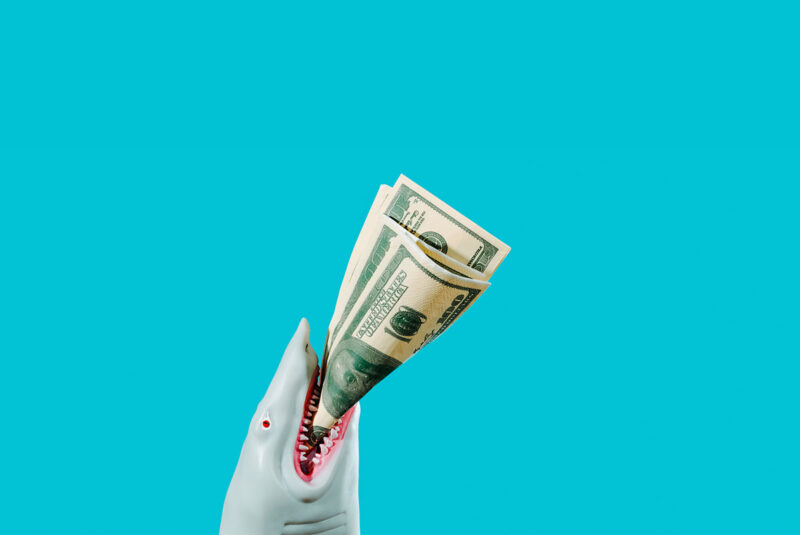Explore your mortgage options
At the most basic level, a personal loan is a sum of money that someone borrows from a lender. The borrower is then legally obligated to repay the loan, plus interest.
In this article, we’ll explain in more detail the mechanics of how personal loans work, what people use them for, the different types and what the requirements are.
Need Cash?
Applying for a personal loan has never been easier. Get the cash you need with competitive terms from Rocket LoansSM.
Checking your options won’t affect your credit score.
What Is a Personal Loan and How Do They Work?
A personal loan is a lump sum of money a lender provides to a borrower, to be paid back over time with interest. The hopeful borrower will begin the process by choosing a lender, specifying how much money they’d like to borrow and filling out an application for the loan.
Most personal loans are unsecured loans. This means that the borrower does not need to put down collateral in order to be approved for the loan.
The lender (usually a bank, credit union or online lender) will review the borrower’s application. They will assess risk factors like the applicant’s credit history and debt-to-income (DTI) ratio. The riskier they deem the applicant, the less likely they are to approve the loan.
Loan terms
If the applicant gets approved for the loan, the lender will provide the applicant with a loan agreement. This agreement will include the key specifics of the loan, known generally as the loan terms. Here are the main ones:
- Loan amount: This is the total amount the lender will loan to the borrower.
- Interest rate: Charged as a percentage of the loan principal, this is how much the lender charges for loaning you money.
- Lender fees: Lenders usually charge one-time fees, like origination fees and administrative fees, related to drawing up the paperwork to make the loan official.
- Monthly payments: How much you’ll owe the lender each month. If you have a fixed-rate personal loan, this amount shouldn’t change over the life of the loan.
- Repayment terms: How long the borrower has to repay the loan. The time frame is usually written in months.
- Conditions: Any special requirements for the lender to issue the loan, like if the lender requires a co-signer to issue the loan.
If the borrower agrees to the loan terms, they sign the necessary documents, close on the loan, and the money is transferred to them, usually in a lump sum.
Depending on when you apply for a personal loan, the process can be completed quite quickly, sometimes within the same business day.
What happens if you can’t make your monthly payment?
Once the funds have been transferred, the borrower is legally obligated to make monthly payments. But what happens if you can’t make those payments? This is known as defaulting on your loan, and there are several potential negative consequences.
- Damage to your credit score: Defaulting on a loan is one of the worst things you can do to damage your credit score. It can take a long time to rebuild your credit afterward.
- Litigation: You can be sued by a collection agency for the money you owe.
- Garnished wages: If a court rules against you, your employer could withhold a portion of your wages to be paid directly to your creditor.
- Lien on your home: If you own a home, a court judgment against you could place a lien or encumbrance on the home. This could give your creditor a legal claim to the property.
The consequences of default can be quite dire, so you should make absolutely sure you’ll be able to make your monthly payments before taking out a personal loan.
What Are Personal Loans Used For?
The short answer is that personal loans are one of the most flexible loan types and you can use them in a lot of different ways. Below are some of the most typical ways people use personal loans:
Debt consolidation
Credit card debt has a way of creeping up on people. But regardless of your sources of debt, there can be several advantages to taking out a personal loan to consolidate your debt. It can simplify your payment, lower your monthly payment by extending the loan term and potentially even save you on interest.
Existing Debt Got You Down?
Let Rocket LoansSM help you with a debt consolidation loan. With same-day funding options, you can get back on track fast.
Checking your options won’t affect your credit score.
Auto expenses
Owning a vehicle can come with a lot of unexpected expenses. If you need an expensive repair that you weren’t budgeting for, a personal loan could be exactly what you need to get back on the road fast.
That said, if you’re looking for financing options to purchase a new or used vehicle, make sure to understand the differences between a car loan and a personal loan.
Home improvement
Finally ready to tackle that kitchen renovation? Maybe you want to upgrade the upstairs bathroom? Personal loans are one of the most common types of home improvement loans.
They’re popular because people can usually get them quickly and there’s no collateral required, like a down payment. They also don’t come with the same closing costs you’d see with other options like a home equity loan.
Home Improvement Is Worth It
Prequalify for a personal loan from $2,000 to $45,000 from Rocket LoansSM and make your dream home a reality.
Life events
With the boom of the wedding industry, it’s becoming more common to see people taking out wedding loans to help them cover costs. Vacation loans can also help people take vacations they otherwise wouldn’t be able to afford.
Remember, while personal loans can help you afford once-in-a-lifetime experiences, you’ll likely be repaying the loan for years. So make certain it’s worth taking out the loan and you can afford repayments before doing so.
Emergencies
Financial experts recommend saving up for an emergency fund so that you have some cover for life’s rainy days. However, this is easier said than done, and just because you’ve started saving for an emergency fund doesn’t mean that nothing will happen until you’ve built up a buffer.
Taking out a personal loan for medical expenses is an example of how these loans can help you weather unexpected storms.
How Much Do Personal Loans Cost?
This depends on how much you borrow and what lender you use. Annual percentage rate (APR) is the best metric to use to calculate this because it shows how much you’ll pay in interest and lender fees for one year of borrowing.
Keep in mind, the more you borrow, the more expensive the loan will be. That’s because both interest and some fees are calculated as percentages of the loan amount. Let’s look at an example:
Let’s say your lender charges a 9% loan origination fee. If you’re borrowing $5,000, you’d owe an origination fee of $450. If you’re borrowing $20,000, you’d owe a fee of $1,800.
Types of Personal Loans
Unsecured and secured loans are the two primary types of personal loans. You can also label personal loans based on their intended use (like a debt consolidation loan) but in terms of the mechanics of the loan there are only two types.
Secured Loans: These require you to put some form of collateral down for the loan. This can be anything from property, such as an automobile or a house, to valuable assets like works of art or stocks. The important thing to remember is that without collateral, a lender will not issue this type of loan, and if you default on this type of loan, the lender will take the collateral as payment.
Unsecured Loans: These loans do not require collateral. Instead, a lender will decide whether or not to give you the loan based on financial factors, such as your credit score and DTI ratio.
Personal Loan Requirements
Specific personal loan requirements will vary depending on the lender you’re using and how much you’re looking to borrow. That said, here are the factors they’ll review:
Personal Loan Requirements
It’s possible to get a personal loan with no credit history. However, if you want to qualify for higher loan amounts and better interest rates, you’ll need to meet the credit score thresholds set by the lender for the loan. Personal loan applicants with excellent credit will also receive better loan terms.
It’s also possible to get a personal loan without a job. However, similar to your credit history, if you can prove that you have stable employment with a good income, you could qualify for a larger amount with better terms. You can also qualify for a personal loan if you’re self-employed.
This is a combination of how much you earn and your outstanding debts. A lower DTI ratio makes it more likely that a lender will approve your loan.
Lenders can’t just take your word regarding your finances. They’ll need to review documents like W-2s, pay stubs, bank statements and tax returns. They’ll also need proof of identity and address so that they know you are who you say you are.
Pros and Cons of Personal Loans
To help you decide if a personal loan is the right option for you, we’ve compiled a list of advantages and risks that come with this type of loan.
Pros of a personal loan
- Flexible: Personal loans can be used for almost anything, making them a viable option for many financial scenarios.
- Fast approval: You can access the funds from a personal loan as quickly as one business day in some cases. This is significantly faster than other options like a mortgage or a home equity loan.
- Smaller upfront expenses: There’s no down payment required for a personal loan, and your closing costs are less than for other types of loans. Not only can you get access to cash fast, but also with a smaller initial financial hurdle.
Cons of a personal loan
- Higher interest rates: While interest rates are typically lower than what you might find for credit cards, generally speaking these are some of the highest interest rates of any loan type.
- Limited loan values: A personal loan will probably be too small to make large-scale purchases like a house.
- Potential for overborrowing: Personal loans are relatively accessible options for receiving a large lump sum of cash. This can make it tempting to borrow more than you need or more than you can afford to pay back.
Alternatives To Personal Loans
If you’re still unsure if a personal loan is right for you, there are plenty of alternatives to consider. Here are some of the most popular options:
Credit cards
Many people are understandably wary of credit cards due to the potential to rack up debt. However, when used responsibly credit cards can actually improve your credit score. Many come with additional benefits like cash back or travel points.
Home equity line of credit (HELOC)
HELOCs allow you to essentially open up a line of credit using the equity in your home as collateral. You can borrow as much as you’d like during the draw period, up to the limit set by your lender. You’ll then be responsible for paying what you borrowed back during the repayment period.
Cash-out refinance
A cash-out refinance replaces your existing mortgage with a new one that’s larger than the amount you currently owe. You receive the difference in cash, so you’ll still need to make monthly payments on the new mortgage, but you get the benefit of the extra cash in hand.
FAQs about Personal Loans
Yes, it’s possible to get a personal loan with bad credit. Keep in mind that you probably won’t be able to take out as big of a loan, and you will likely pay higher interest rates.
Legally, personal loans fall under the umbrella term “installment loans.” So long as you meet a lender’s requirements, there’s no set cap on how many of these loans you can take out.
Keep in mind, any loans you take out will affect your debt-to-income ratio. Effectively, the limit comes when a lender will no longer approve you for another installment loan for having a high DTI.
Remember, you’re paying interest and fees on top of your monthly payments, so you should only take out a personal loan if you plan to use it. That said, so long as the conditions of your loan don’t specify what you need to do with it, the lender won’t care so long as you’re making your monthly payments.
Yes, it is possible to refinance a personal loan and adjust the loan terms.
Final Thoughts on Personal Loans
Personal loans are popular because they are flexible, fast and can be easier to qualify for than other types of loans. They also come with predictable repayment terms, which is advantageous for future financial planning.
Just remember to do your due diligence before applying; make sure that you don’t borrow more than you need and that you can afford to make the monthly payments on what you do borrow.
See What a Personal Loan Can Do for You
Our partners at Rocket LoansSM are ready to help.
Checking your options won’t affect your credit score.
The Short Version
- Most personal loans are unsecured loans, meaning the borrower doesn’t need to put down collateral. Lenders will make a decision based on financial factors in the application
- Debt consolidation, home improvement and emergency expenses are some of the most common reasons that people take out personal loans
- Annual percentage rate (APR) is the best way to calculate how much a personal loan will cost because it combines interest rates and lender fees




